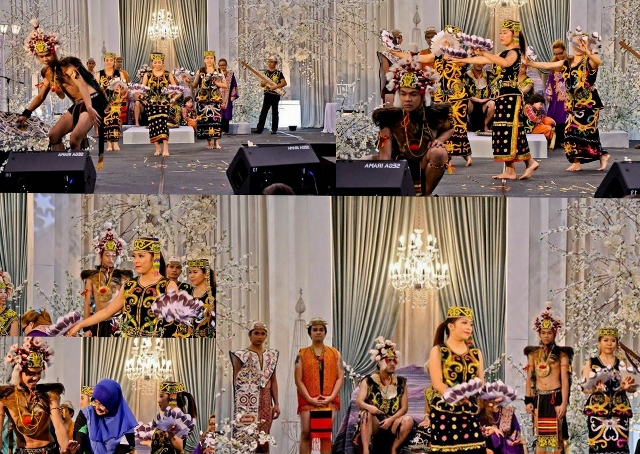The Courtship and Proposal
Traditionally, the proper manner to get bethrothed is for the man’s parents to send an emissary to the woman’s parents for the purpose of asking the daughter’s hand in marriage. This process is known as tei Nyiouk(Kayan) or tai nesek/mutu ledo (Kenyah). An engagement token is given by the man to the woman in the presence of the headman, village elders & relatives. This custom is known in Kayan as atep hawa. The value of the token varies according to individual status.

The Wedding Ceremony
On the wedding day , people from the longhouse neighbouring are invited to attend the celebration. The marriage is then solemnized by the headman, in the presence of few elders acting as witnesses & guests.
At the wedding ceremony, the couple dressed in traditional costumes, take their seats on a tawak (gong). Firmly placed their hands on top of each other with their palms clutching the handle of a ceremonial sword, malat buk (Kayan). The blade of the sword is pinned down to the floor. While sitting in this position, 8 bridesmaids carrying a sun-hat, sa’ong in Kenyah, each placed above the heads of the couple to symbolically protect them from the sun & rain. Minutes later, the bride & groom present gifts of sarong to the bridesmaids before leaving.
After this, the sword is removed from the grips of the couple and placed into the scabbard. Before leaving the place, they are asked to feed each other a few grains of rice, baa’ (Kenyah) which they must chew & eat. They are then asked to tai nao’ abut jan (Kenyah) meaning ‘work in the farm’. The coupleare then accompanied by eight men & women to walk in the single file from the bride’s amin, along the length of the gallery then down the ladder to the ground. A man who leads the line carries a small gong, sanang (Kayan/Kenyah) in his hands beating it lightly with a baton as he walks along, keeping in rank with the rest in the procession. At the end of the column is another person, though not necessarily the last in the row, carrying a woven rattan basket, balukoi (Kenyah) on his back where he puts eight pieces of firwood. The procession walks along the gallery, down the latter to the ground an up the longhouse eight times. Each time the procession gets to the ground he places a piece of the firewood on the ground. When the ritual is over the procession breaks up and the newly wed take their seats with the rest of the guests & friends.
From then the merry making such as dancing, saga’ (Kenyah) & singing, belian (Kenyah) starts. Burak (Kayan/Kenyah), brewed rice wine will be served. Burak is made by fermenting the rice at least one or two weeks before the wedding. Everyone must drink, particularly to taste the wedding telang jakan as this particular burak is poetically called. The wedding night is often known as malem bu’et (Kenyah), meaning short night also referring to the lack of sleep or none of it that night.
The global perception of a happy marriage is LOVE. This involves tolerance, understanding & faithfulness. A happy marriage will not only bring peace of mind to the couple but respect.
 Kayan Wedding? Please Vote!
Kayan Wedding? Please Vote!


